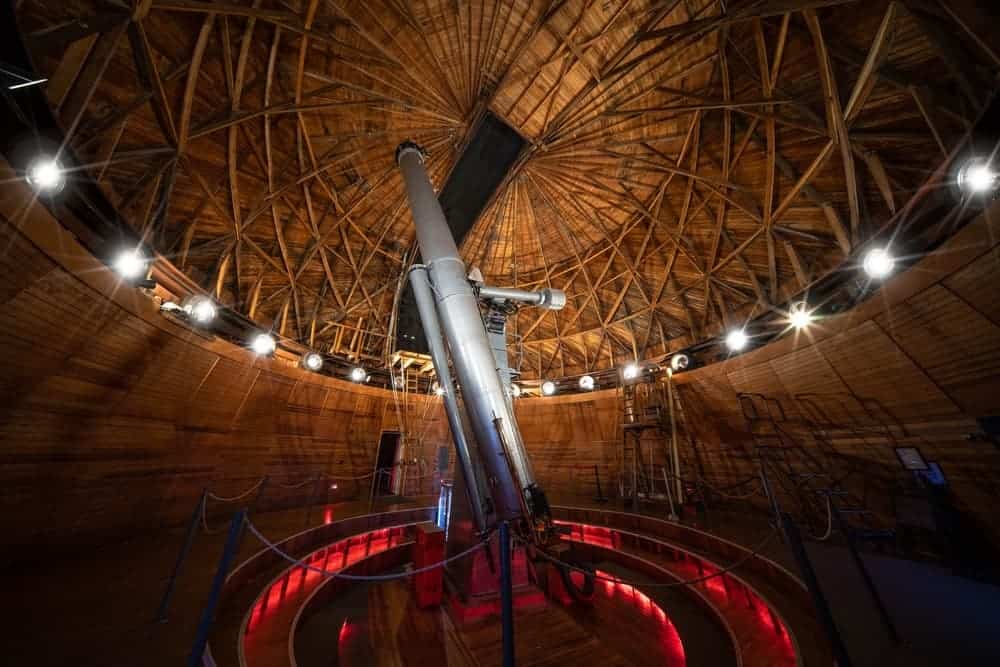The Lowell Observatory is located in Flagstaff, Arizona, and is a well-known historical site where many great strides in the world of astronomy have been made.
If you are interested in the planets, stars, galaxies, etc., you probably already know what the Lowell Observatory is and why people should visit.
However, if you haven’t heard of this famous observatory but are a fan of astronomy, you need to put this stop on your list of places to visit ASAP.
Contents
What Is the Lowell Observatory?
The Lowell Observatory sits atop Mars Hill Mesa in the state of Arizona. It is one of the oldest observatories in the USA, having opened its doors in 1894.
The observatory was founded by an astronomer named Percival Lowell specifically for studying Mars. His interests were mainly focused on the possibility that intelligent life forms lived on the red planet.
Over the years, the observatory has undergone many upgrades and increased the research and science conducted here. And in 1965, this iconic building was designated a National Historic landmark. The honor was for the many accomplishments achieved in this location.
Today the observatory is one of the top astronomical research institutes, with plenty of history, technology, and beautiful experiences that visitors can partake in while touring the site.
Why Is It Important?

Although Lowell never found proof of extraterrestrial life, he made giant steps in the field of astronomy. Still to this day, exciting and new advancements come from this influential tourist destination.
The Lowell Observatories Success Timeline:
- 1894: Founder Percival Lowell established the observatory in an attempt to locate life on Mars.
- 1896: Lowell hired famous telescope makers Alvan Clark & Sons to make a 24-inch refractor on a telescope with a 22.6-foot focal length. This telescope is still known for being one of the best ever made.
- 1912: V.M. Slipher was working in the observatory when he detected signs of the expansion of the universe.
- 1930: A self-taught astronomer, Clyde Tombaugh, was using the Lawrence Lowell telescope (13 inches) and discovered Pluto in the Lowell Observatory.
- 1958: Scientists at the observatory convinced Flagstaff authorities to sanction the first lighting ordinance ever put in place anywhere to preserve the night sky.
- 1969: Lowell Observatory and its 24-inch refractor took part in the July 20 moon landing. This began almost a decade before when a U.S. Air Force cartographer utilized Lowell’s instruments to design important maps or lunar charts to navigate crew landing on the moon.
- 1977: Multiple telescopes were used from the Lowell Observatory to discover the rings around Uranus.
- 1988: Telescopes used by astronomers at Lowell’s Observatory helped discover the atmosphere of dwarf planet Pluto.
Since its inception, the Lowell Observatory has assisted in many revolutionary discoveries throughout the history of astronomy, paving the way for future breakthroughs.
If not for the infamous observatory and the many scientists, astronomers, and other highly regarded professionals who worked there, we may have very well been in the dark about many things in space.
Things to Do at the Lowell Observatory in Flagstaff

With so many monumental findings in this highly regarded observatory, it is no surprise that it has become a popular destination for people across the country. And the observatory is more than happy to accommodate and entertain them all.
Aside from doing your own stargazing on Mars Hill, here are a few other fun things to do at the Lowell Observatory.
Take a Unique and Fascinating Historical Tour
The Lowell Observatory offers two guided tours, each taking about 45 minutes. The tours are included with general admission and give guests a unique glimpse into what life was like for historical astronomers using the then-groundbreaking equipment.
- The Lowell Tour takes you through Percival Lowell’s life from the planning phase for the observatory and every milestone and accomplishment made thereafter.
- The Story of Pluto Tour takes place in the “Pluto Dome” and educates guests on Clyde Tombaugh’s discovery of Pluto in 1930 at the Lowell Observatory.
You don’t want to pass up these tours when planning your visit. You will be fascinated by the stories shared and told like never before.
Premium Access to the Latest Telescope at the Observatory: 24” Dyer Telescope
Although this experience is a little pricey ($575 flat rate for up to 10 people), it is definitely worth the money.
Booking this up-close personalized experience allows visitors to view the universe like never before in 75 exciting minutes of premium access to one of the most impressive telescopes ever made.
You will have experts guiding you through the viewing process, providing you with an array of impressive celestial targets to hone in on while you look through the popular 24” Dyer telescope.
Lowell Discovery Telescope Excursion
For $150 per person, you can do some pretty serious stargazing with the fifth-largest telescope in the U.S. This telescope is used today by planetary scientists and astronomers from various institutions to do pioneering work and better understand what is happening in our solar system and beyond.
General admission and a ride from Mars Hill observatory to the LDT in Happy Jack and back are included with the purchase of this experience.
- Important Note: When visiting the museum for stargazing or to get a peek into outer space with ground-breaking equipment, weather can play a significant role in your experience. If the weather is not cooperating, tours and other experiences may be canceled last minute.
Why Should You Visit the Lowell Observatory?
The Lowell Observatory in Flagstaff, Arizona, is one of the most notable facilities in the history of astronomy. It is home to world-renowned telescopes and has assisted in discoveries that have paved the way for advanced research, getting a deeper look into a massive Universe that holds many secrets.
This Observatory is full of inspirational and interesting artifacts, along with a group of highly educated staff that can help you see our world in a whole new way.

